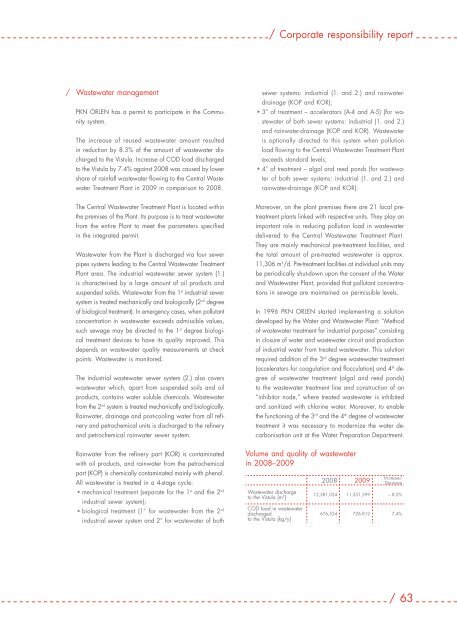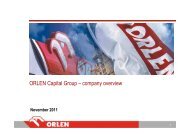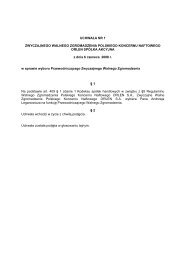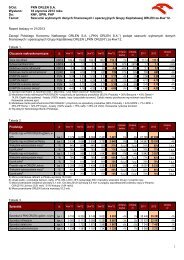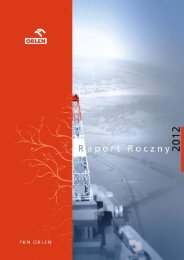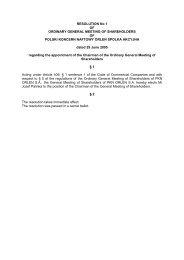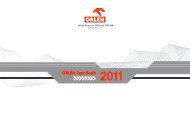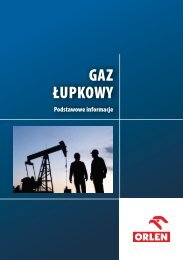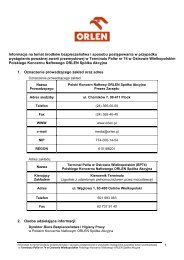Corporate responsibility report / Responsible brand - PKN Orlen
Corporate responsibility report / Responsible brand - PKN Orlen
Corporate responsibility report / Responsible brand - PKN Orlen
You also want an ePaper? Increase the reach of your titles
YUMPU automatically turns print PDFs into web optimized ePapers that Google loves.
<strong>Corporate</strong> <strong>responsibility</strong> <strong>report</strong><br />
/ Wastewater management<br />
<strong>PKN</strong> ORLEN has a permit to participate in the Community<br />
system.<br />
The increase of reused wastewater amount resulted<br />
in reduc tion by 8.3% of the amount of wastewater discharged<br />
to the Vistula. Increase of COD load discharged<br />
to the Vistula by 7.4% against 2008 was caused by lower<br />
share of rainfall wastewater flowing to the Central Wastewater<br />
Treatment Plant in 2009 in comparison to 2008.<br />
sewer systems: industrial (1. and 2.) and rainwaterdrainage<br />
(KOP and KOR);<br />
• 3° of treatment – accelerators (A-4 and A-5) (for wastewater<br />
of both sewer systems: industrial (1. and 2.)<br />
and rainwater-drainage (KOP and KOR). Wastewater<br />
is optionally directed to this system when pollution<br />
load flowing to the Central Wastewater Treatment Plant<br />
exceeds standard levels;<br />
• 4° of treatment – algal and reed ponds (for wastewater<br />
of both sewer systems: industrial (1. and 2.) and<br />
rainwater-drainage (KOP and KOR).<br />
The Central Wastewater Treatment Plant is located within<br />
the premises of the Plant. Its purpose is to treat wastewater<br />
from the entire Plant to meet the parameters specified<br />
in the integrated permit.<br />
Wastewater from the Plant is discharged via four sewer<br />
pipes systems leading to the Central Wastewater Treatment<br />
Plant area. The industrial wastewater sewer system (1.)<br />
is characterised by a large amount of oil products and<br />
suspended solids. Wastewater from the 1 st industrial sewer<br />
system is treated mechanically and biologically (2 nd degree<br />
of biological treatment). In emergency cases, when pollu tant<br />
concentration in wastewater exceeds admissible values,<br />
such sewage may be directed to the 1 st degree biological<br />
treatment devices to have its quality improved. This<br />
depends on wastewater quality measurements at check<br />
points. Wastewater is monitored.<br />
The industrial wastewater sewer system (2.) also covers<br />
wastewater which, apart from suspended soils and oil<br />
products, contains water soluble chemicals. Wastewater<br />
from the 2 nd system is treated mechanically and biologically.<br />
Rainwater, drainage and post-cooling water from all refinery<br />
and petrochemical units is discharged to the refinery<br />
and petrochemical rainwater sewer system.<br />
Rainwater from the refinery part (KOR) is contaminated<br />
with oil products, and rainwater from the petrochemical<br />
part (KOP) is chemically contaminated mainly with phenol.<br />
All wastewater is treated in a 4-stage cycle:<br />
• mechanical treatment (separate for the 1 st and the 2 nd<br />
industrial sewer system);<br />
• biological treatment (1° for wastewater from the 2 nd<br />
industrial sewer system and 2° for wastewater of both<br />
Moreover, on the plant premises there are 21 local pretreatment<br />
plants linked with respective units. They play an<br />
important role in reducing pollution load in wastewater<br />
delivered to the Central Wastewater Treatment Plant.<br />
They are mainly mechanical pre-treatment facilities, and<br />
the total amount of pre-treated wastewater is approx.<br />
11,306 m 3 /d. Pre-treatment facilities at individual units may<br />
be periodically shut-down upon the consent of the Water<br />
and Wastewater Plant, provided that pollutant concentrations<br />
in sewage are maintained on permissible levels.<br />
In 1996 <strong>PKN</strong> ORLEN started implementing a solution<br />
developed by the Water and Wastewater Plant: “Method<br />
of wastewater treatment for industrial purposes” consisting<br />
in closure of water and wastewater circuit and production<br />
of industrial water from treated wastewater. This solution<br />
required addition of the 3 rd degree wastewater treatment<br />
(accelerators for coagulation and flocculation) and 4 th degree<br />
of wastewater treatment (algal and reed ponds)<br />
to the wastewater treatment line and construction of an<br />
“inhibitor node,” where treated wastewater is inhibited<br />
and sanitized with chlorine water. Moreover, to enable<br />
the functioning of the 3 rd and the 4 th degree of wastewater<br />
treatment it was necessary to modernize the water decarbonisation<br />
unit at the Water Preparation Department.<br />
Volume and quality of wastewater<br />
in 2008–2009<br />
Wastewater discharge<br />
to the Vistula [m 3 ]<br />
COD load in wastewater<br />
discharged<br />
to the Vistula [kg/y]<br />
2008 2009<br />
Increase/<br />
Decrease<br />
12,381,024 11,351,599 – 8.3%<br />
676,524 726,812 7.4%<br />
/ 63


